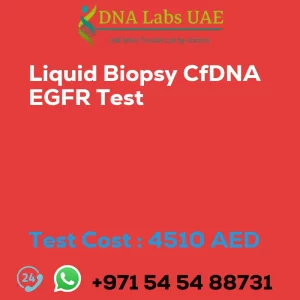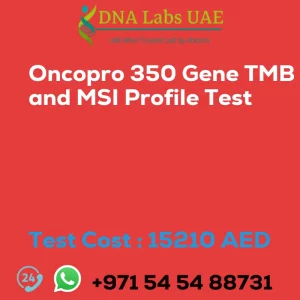IMMUNOPHENOTYPING BY FLOW CYTOMETRY LYMPHOMA DIAGNOSTIC PANEL Test
Test Name: IMMUNOPHENOTYPING BY FLOW CYTOMETRY LYMPHOMA DIAGNOSTIC PANEL Test
Test Components: Immunophenotyping by flow cytometry
Price: 3980.0 AED
Sample Condition:
- Blood: 3 mL (2 mL min.) whole blood from 1 Lavender Top (EDTA) tube.
- Bone Marrow: 3 mL (1.5 mL min.) in 1 Green Top (Sodium Heparin) tube.
- Body Fluids: 50 mL (10 mL min.) fluids in a sterile screw capped container.
- Lymph Node Aspirate: 1 mL (0.5 mL min.) in normal saline.
Report Delivery: Sample Daily by 9 am; Report Same day
Method: Flow Cytometry
Test Type: Cancer
Doctor: Oncologist, Hematologist
Test Department: FLOW CYTOMETRY
Pre Test Information: Clinical history is mandatory.
Test Details:
Immunophenotyping by flow cytometry is a diagnostic test used to identify and classify lymphomas. It involves the use of specific antibodies labeled with fluorescent dyes to detect and quantify the presence of different cell surface markers on lymphocytes. The lymphoma diagnostic panel typically includes a combination of antibodies that target markers specific to different types of lymphocytes and their maturation stages. These markers can help differentiate between different types of lymphomas, such as B-cell lymphomas, T-cell lymphomas, and Hodgkin lymphoma. Some common markers included in the lymphoma diagnostic panel may include CD19, CD20, CD3, CD5, CD10, CD23, CD30, CD15, and CD45. The expression or absence of these markers can provide valuable information about the type and stage of the lymphoma.
During the flow cytometry procedure, a blood or tissue sample is collected from the patient and labeled with the fluorescently labeled antibodies. The sample is then passed through a flow cytometer, which uses laser beams to detect and measure the fluorescence emitted by the labeled cells. The data obtained from the flow cytometer is then analyzed to determine the immunophenotype of the lymphoma cells.
The results of the immunophenotyping test can help guide the diagnosis and treatment of lymphomas. It can provide information about the specific type of lymphoma, its aggressiveness, and potential treatment options. This test is often used in conjunction with other diagnostic techniques, such as histopathology and genetic testing, to provide a comprehensive diagnosis.
| Test Name | IMMUNOPHENOTYPING BY FLOW CYTOMETRY LYMPHOMA DIAGNOSTIC PANEL Test |
|---|---|
| Components | |
| Price | 3980.0 AED |
| Sample Condition | Blood: 3 mL (2 mL min.) whole blood from 1 Lavender Top (EDTA) tube.\nBone Marrow: 3 mL (1.5 mL min.) in 1 Green Top (Sodium Heparin) tube.\nBody Fluids: 50 mL (10 mL min.) fluids in a sterile screw capped container.\nLymph Node Aspirate: 1 mL (0.5 mL min.) in normal saline. \nShip at 18\u0192??22?\u00f8C. DO NOT REFRIGERATE OR FREEZE. Clinical history is mandatory. |
| Report Delivery | Sample Daily by 9 am; Report Same day |
| Method | Flow Cytometry |
| Test type | Cancer |
| Doctor | Oncologist, Hematologist |
| Test Department: | FLOW CYTOMETRY |
| Pre Test Information | Clinical history is mandatory. |
| Test Details |
Immunophenotyping by flow cytometry is a diagnostic test used to identify and classify lymphomas. It involves the use of specific antibodies labeled with fluorescent dyes to detect and quantify the presence of different cell surface markers on lymphocytes. The lymphoma diagnostic panel typically includes a combination of antibodies that target markers specific to different types of lymphocytes and their maturation stages. These markers can help differentiate between different types of lymphomas, such as B-cell lymphomas, T-cell lymphomas, and Hodgkin lymphoma. Some common markers included in the lymphoma diagnostic panel may include CD19, CD20, CD3, CD5, CD10, CD23, CD30, CD15, and CD45. The expression or absence of these markers can provide valuable information about the type and stage of the lymphoma. During the flow cytometry procedure, a blood or tissue sample is collected from the patient and labeled with the fluorescently labeled antibodies. The sample is then passed through a flow cytometer, which uses laser beams to detect and measure the fluorescence emitted by the labeled cells. The data obtained from the flow cytometer is then analyzed to determine the immunophenotype of the lymphoma cells. The results of the immunophenotyping test can help guide the diagnosis and treatment of lymphomas. It can provide information about the specific type of lymphoma, its aggressiveness, and potential treatment options. This test is often used in conjunction with other diagnostic techniques, such as histopathology and genetic testing, to provide a comprehensive diagnosis. |








